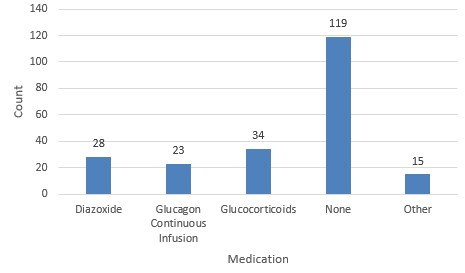Neonatal General
Category: Abstract Submission
Neonatology General 7: ROP - Endocrine
437 - Survey of Neonatologists perspectives regarding diagnosis and management of hypoglycemia
Friday, April 22, 2022
6:15 PM - 8:45 PM US MT
Poster Number: 437
Publication Number: 437.137
Publication Number: 437.137
Daniela Dinu, Baylor College of Medicine, Houston, TX, United States; Joseph Hagan, Baylor College of Medicine, Houston, TX, United States; Paul J. Rozance, University of Colorado, Aurora, CO, United States
- DD
Daniela Dinu, MD
Associate Professor
Baylor College of Medicine
Houston, Texas, United States
Presenting Author(s)
Background: Hypoglycemia is the most common metabolic derangement encountered during the newborn period. Guidelines regarding diagnosis and management of hypoglycemia in newborns at risk have been published, however these guidelines do not refer specifically to newborns admitted to NICU.
Objective: This study investigated current neonatologist practices regarding diagnosis and management of hypoglycemia for newborns admitted to the NICU.
Design/Methods: An electronic survey was sent to US neonatologists which included 34 questions about: use of glucose screening protocol, glucose thresholds used for diagnosis of hypoglycemia and type of interventions.
Results: Our rate of response was 6.3% (223/3564). 43.6% of respondents identified their NICU as academic, 39.0% community with academic affiliation and 17.4% as private practice. 87.8 % (195/222) have a protocol for managing hypoglycemia: 84/195 use AAP guidelines, and 93/225 a combination of PES and AAP guidelines. 74.2% screen all babies admitted to NICU for hypoglycemia. Median glucose concentration identified as the threshold for hypoglycemia was 45 mg/dL (25-60) in first 48 hours of life for preterm, term, symptomatic or asymptomatic newborns; while 50 mg/dL (30-70) was the median glucose value after 48 hours of life. The following were reported as treatment for hypoglycemia in the NICU: 44.8% (99/221) use dextrose gel, with 44/99 using maximum two doses and 43/99 using three doses.17.1% (38/222) use enteral dextrose. 68.8% (152/221) increase the caloric content of feeds .using formula, milk fortifier or complex carbohydrates and 47.5% (104/219) use continuous feeds as a treatment in the first week of life and 62.9% (139/221) after the first week. 54.3% 119/219) use no medications in the first week of life. 15.5% (34/219) use glucocorticoids. 76.9% (185/213) use Diazoxide as the first line medication for hyperinsulinism, alone or combined with Diuril. One of the few differences between academic and private practice Neonatologists was that private practice Neonatologists were more likely to use Diazoxide as the first line medication for hyperinsulinism (P=0.041) A Pediatric Endocrinology consult would be obtained by 56% (117/209) of Neonatologists if there is need for intravenous dextrose for more than 7 days, and by 21.1% (44/209) if there is a need for dextrose for more than 14 days.Conclusion(s): There is large variability in practice regarding diagnosis and management of hypoglycemia most likely due to lack of evidence regarding a certain glucose value and developmental outcomes, as well as a lack of evidence regarding efficacy of various management options.
Glucose values identified as threshold for hypoglycemia.jpg) Figure 1
Figure 1
Medication used in first week of life Figure 2
Figure 2
Objective: This study investigated current neonatologist practices regarding diagnosis and management of hypoglycemia for newborns admitted to the NICU.
Design/Methods: An electronic survey was sent to US neonatologists which included 34 questions about: use of glucose screening protocol, glucose thresholds used for diagnosis of hypoglycemia and type of interventions.
Results: Our rate of response was 6.3% (223/3564). 43.6% of respondents identified their NICU as academic, 39.0% community with academic affiliation and 17.4% as private practice. 87.8 % (195/222) have a protocol for managing hypoglycemia: 84/195 use AAP guidelines, and 93/225 a combination of PES and AAP guidelines. 74.2% screen all babies admitted to NICU for hypoglycemia. Median glucose concentration identified as the threshold for hypoglycemia was 45 mg/dL (25-60) in first 48 hours of life for preterm, term, symptomatic or asymptomatic newborns; while 50 mg/dL (30-70) was the median glucose value after 48 hours of life. The following were reported as treatment for hypoglycemia in the NICU: 44.8% (99/221) use dextrose gel, with 44/99 using maximum two doses and 43/99 using three doses.17.1% (38/222) use enteral dextrose. 68.8% (152/221) increase the caloric content of feeds .using formula, milk fortifier or complex carbohydrates and 47.5% (104/219) use continuous feeds as a treatment in the first week of life and 62.9% (139/221) after the first week. 54.3% 119/219) use no medications in the first week of life. 15.5% (34/219) use glucocorticoids. 76.9% (185/213) use Diazoxide as the first line medication for hyperinsulinism, alone or combined with Diuril. One of the few differences between academic and private practice Neonatologists was that private practice Neonatologists were more likely to use Diazoxide as the first line medication for hyperinsulinism (P=0.041) A Pediatric Endocrinology consult would be obtained by 56% (117/209) of Neonatologists if there is need for intravenous dextrose for more than 7 days, and by 21.1% (44/209) if there is a need for dextrose for more than 14 days.Conclusion(s): There is large variability in practice regarding diagnosis and management of hypoglycemia most likely due to lack of evidence regarding a certain glucose value and developmental outcomes, as well as a lack of evidence regarding efficacy of various management options.
Glucose values identified as threshold for hypoglycemia
.jpg) Figure 1
Figure 1Medication used in first week of life
 Figure 2
Figure 2